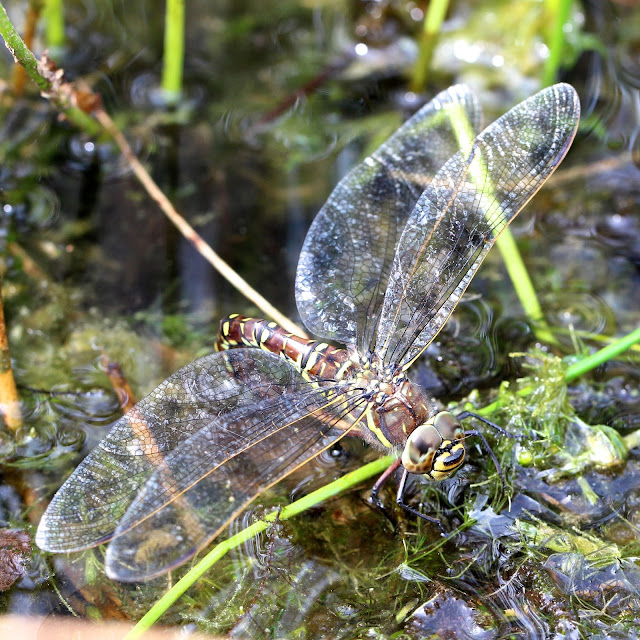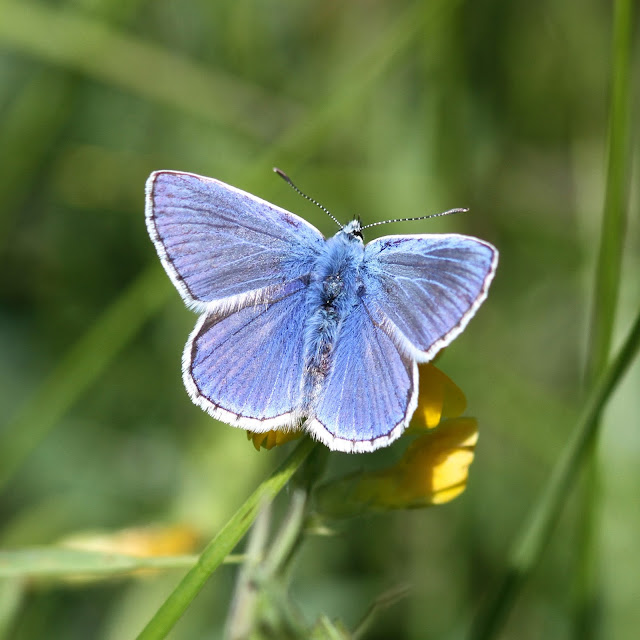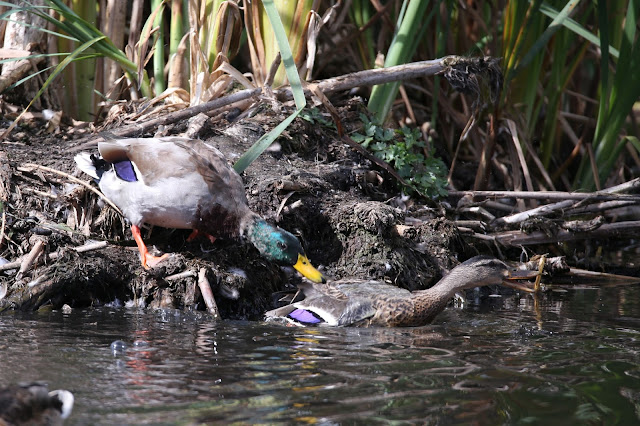This young roe deer surprised me and was almost too close to fit in the frame of my 300mm lens. It didn't stay long.
My Blog List
Thursday, 31 August 2017
Tuesday, 29 August 2017
Common things are common
"Common things are common" is a phrase familiar to medical students learning about differential diagnosis. There have been a lot of common things to see recently when I have been out and about this summer.
The common darter (Sympetrum striolatum) is certainly the commonest dragonfly at the moment.
Common hawkers (Aeshna juncea) are less common than common darters and seem to be less common than southern hawkers.
Common blue damselflies (Enallagma cyathigerum) are still the most numerous at this time of year.
Common blue butterflies (Polyommatus icarus) are the only blue butterflies I have seen this year.
The common carder bee (Bombus pascuorum) is by far the commonest bumblebee in the garden just now.
The common green grasshopper (Omocestus viridulus) is common but not always green.
Common lizards (Zootoca vivipara) are not common but I was lucky enough to see several last month.
Common means "prevalent, or occurring, found or done often". It can also mean "vulgar or lacking refinement", which certainly couldn't be said of my common pheasant (Phasianus colchicus).
The common darter (Sympetrum striolatum) is certainly the commonest dragonfly at the moment.
Common hawkers (Aeshna juncea) are less common than common darters and seem to be less common than southern hawkers.
Common blue damselflies (Enallagma cyathigerum) are still the most numerous at this time of year.
Common blue butterflies (Polyommatus icarus) are the only blue butterflies I have seen this year.
The common carder bee (Bombus pascuorum) is by far the commonest bumblebee in the garden just now.
The common green grasshopper (Omocestus viridulus) is common but not always green.
Common lizards (Zootoca vivipara) are not common but I was lucky enough to see several last month.
Common means "prevalent, or occurring, found or done often". It can also mean "vulgar or lacking refinement", which certainly couldn't be said of my common pheasant (Phasianus colchicus).
Sunday, 27 August 2017
Which brother will be king?
These two young male kingfishers have been putting on a great show in the past couple of weeks. They have no rings and are thought to be from a second brood (most or all of the first brood were ringed). There is a fair amount of conflict as they battle for control of the territory on the lake in Gosforth Park. This time last year there was a single very determined young female in charge but so far neither of these two has been able to oust the other.
We were sitting watching this one
when the second one arrived and wanted to sit on the same piece of reed.
The first wasn't happy and flew a short distance away
leaving the incomer in possession of the reed.
A short while later the two of them were sat on the same stick pretending to ignore each other
but that didn't last.
Then one caught a fish
and brought it to eat in front of his brother
who pretended to take no notice.
There has also been a young female around, probably from the same brood, although I haven't seen her. I expect one of the brothers will take the territory and the other will have to move on.
Friday, 25 August 2017
Word gets around
I think every fox in the neighbourhood now knows about the free food on offer every night in my garden. Last night there were three sat side by side outside the back door although I wasn't set up for a photo. They generally arrive before 10pm and I usually watch through the window or just leave them to it, although occasionally I set the video camera. One recent evening the camera recorded 124 30s clips which, with a short gap between each, means that there was over an hour of recording. The first fox to arrive at around 9.50pm was this one. According to the timings on the videos it stayed for about 10 minutes.
Forty minutes later there were two more. At first the second one lay down a few metres away and just watched. I presume the first one is the dominant animal.
They obviously are prepared to put up with each other but there is some competition for access to the peanuts.
These two eventually disappeared and a fourth one arrived at around 11.15pm, to be joined by a dinner guest. The fox is wary of getting too close to the hedgehog.
You can clearly see on this clip that the fox is injured. It has a limp and a painful swollen right lower leg. I reckon I have seen this one around for several weeks now.
If the fox gets too close the hedgehog flinches but doesn't retreat.
Eventually the hedgehog has had enough (of the food or the fox) and leaves.
Later still, around 2.30am, a fifth fox arrived. It was thinner, and presumably younger, but there wasn't much food left.
It was reduced to catching worms on the lawn (and slurping them down like spaghetti).
Forty minutes later there were two more. At first the second one lay down a few metres away and just watched. I presume the first one is the dominant animal.
They obviously are prepared to put up with each other but there is some competition for access to the peanuts.
These two eventually disappeared and a fourth one arrived at around 11.15pm, to be joined by a dinner guest. The fox is wary of getting too close to the hedgehog.
You can clearly see on this clip that the fox is injured. It has a limp and a painful swollen right lower leg. I reckon I have seen this one around for several weeks now.
If the fox gets too close the hedgehog flinches but doesn't retreat.
Eventually the hedgehog has had enough (of the food or the fox) and leaves.
Later still, around 2.30am, a fifth fox arrived. It was thinner, and presumably younger, but there wasn't much food left.
It was reduced to catching worms on the lawn (and slurping them down like spaghetti).
Wednesday, 23 August 2017
A walk along the river bank
I went for a walk along the bank of the River Nene, near where I grew up and close to the Ox Hovel that I wrote about recently. This time I was looking for dragonflies and almost as soon as I crossed the coach bridge I saw several hawkers flying along the bank and across the meadow. I could see at least three brown hawkers but the first one I saw at rest was this male southern hawker (Aeshna cyanea).
Then I spotted a male brown hawker (Aeshna grandis) low down in the foliage at the edge of the meadow.
I crept around to get a clearer view.
And he let me get quite close.
He was still there when I decided to go farther along the bank. A few metres on I found another southern hawker.
And then another.
And another.
I walked as far as the Ox Hovel but this time there were no solitary bees to be seen - I expect their season is already over. When I walked back the bank was in shadow and there were no dragonflies flying. I think they had all gone over to the other bank to stay in the sunshine.
Then I spotted a male brown hawker (Aeshna grandis) low down in the foliage at the edge of the meadow.
I crept around to get a clearer view.
And he let me get quite close.
He was still there when I decided to go farther along the bank. A few metres on I found another southern hawker.
And then another.
And another.
I walked as far as the Ox Hovel but this time there were no solitary bees to be seen - I expect their season is already over. When I walked back the bank was in shadow and there were no dragonflies flying. I think they had all gone over to the other bank to stay in the sunshine.
Monday, 21 August 2017
Eclipse news - from the mallards
An update on the eclipse of the mallards on the day of a total eclipse of the sun in the USA. I wrote a couple of weeks ago about the mallard drakes in complete camouflage outfits while they waited for their new wing feathers to grow. Some of them, such as this one, are still in eclipse plumage. He seemed quite pleased with himself.
Here he is with a duck for comparison. Note her darker and two-tone beak.
When the sun came out he was doing a bit of yoga.
Then suddenly there was trouble as another drake appeared. This one is well on the way to developing its breeding colour plumage and wanted to take over the mound of rushes.
The first drake jumped into the water to escape so the newcomer attacked the duck
and chased her into the water as well.
Once he had cleared all the others away he gave a victory salute.
The first drake sat and watched until the intruder went away. You can see the green just starting to appear in his head feathers.
And his wing feathers are largely regrown.
This is one of this year's young, now full grown and showing the beautiful indigo speculum feathers.
You can tell it was a quiet day in the hide when the most interesting bird on the lake was a mallard!
Here he is with a duck for comparison. Note her darker and two-tone beak.
When the sun came out he was doing a bit of yoga.
Then suddenly there was trouble as another drake appeared. This one is well on the way to developing its breeding colour plumage and wanted to take over the mound of rushes.
The first drake jumped into the water to escape so the newcomer attacked the duck
and chased her into the water as well.
Once he had cleared all the others away he gave a victory salute.
The first drake sat and watched until the intruder went away. You can see the green just starting to appear in his head feathers.
And his wing feathers are largely regrown.
This is one of this year's young, now full grown and showing the beautiful indigo speculum feathers.
You can tell it was a quiet day in the hide when the most interesting bird on the lake was a mallard!
Subscribe to:
Posts (Atom)

























































